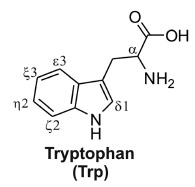Research
Photo-CIDNP:
Photochemically induced dynamic nuclear polarization (photo-CIDNP) is a powerful approach for sensitivity enhancement in NMR spectroscopy. In liquids, intermolecular photo-CIDNP depends on the transient bimolecular reaction between a photoexcited dye and the sample of interest.
The Cavagnero group has exploited the large enhancements arising from 13C photochemically induced dynamic nuclear polarization (13C photo-CIDNP) in solution to improve biomolecular NMR sensitivity in the context of heteronuclear correlation spectroscopy.
The 13C-PRINT pulse sequence involves an initial 13C nuclear spin polarization via photo-CIDNP followed by conversion to anti-phase coherence and transfer to 1H for detection. Substantial enhancements, up to 200 fold, have been achieved compared to the dark (laser off) experiment.[1]


13C photo-CIDNP leads to dramatic NMR 13C-PRINT NMR pulse sequence sensitivity enhancements
The photo-CIDNP resonance intensities of tryptophan in the presence of fluorescein(FL) in the liquid state show that FL yields superior sensitivity and enables rapid data collection down to an unprecedented 1 μM concentration. [2]


Structure of fluorescein(FL) and tryptophan(Trp)

NMR spectroscopy of Trp at 1uM concentration
Left spectrum: NMR spectrum of 1 μM Trp (in H2O, pH 7.0, 2.4 μM FL, 8 scans) collected at 14.1 T (600 MHz) with a room-temperature probe in the presence of photo-CIDNP (1D 13C PRINT).
Right spectrum: The same sample is taken 15872 scans at 21.2 T (900 MHz) with a cryogenic probe (1H−13C SE-HSQC) in the absence of photo-CIDNP.
These two spectra have approximately the same S/N ratio!
Refenrences:
